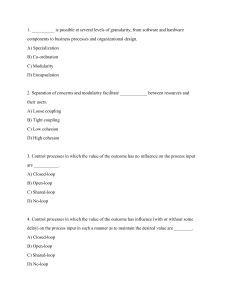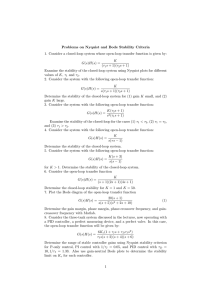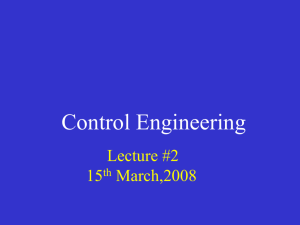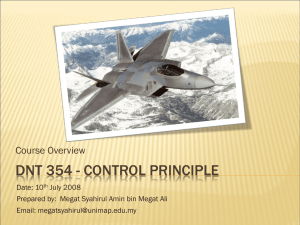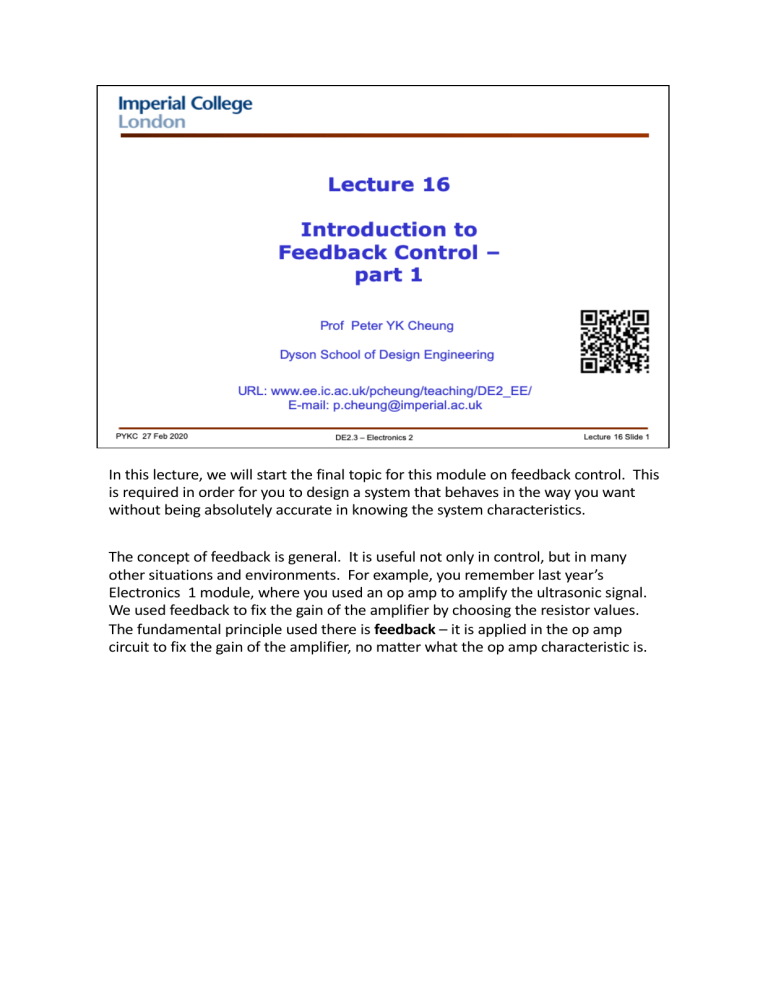
In this lecture, we will start the final topic for this module on feedback control. This is required in order for you to design a system that behaves in the way you want without being absolutely accurate in knowing the system characteristics. The concept of feedback is general. It is useful not only in control, but in many other situations and environments. For example, you remember last year’s Electronics 1 module, where you used an op amp to amplify the ultrasonic signal. We used feedback to fix the gain of the amplifier by choosing the resistor values. The fundamental principle used there is feedback – it is applied in the op amp circuit to fix the gain of the amplifier, no matter what the op amp characteristic is. Before I start this lecture, let us watch a short video explaining what is control engineering: You can find this video on the link: https://www.youtube.com/watch?v=Im88eVfkeBo&t=44s You have in the past been applying control to the DC motors, but without feedback. The potentiometer provide a desired motor speed. This is also known as the “set point”. Here are what we did in Lab 4: 1. The Pybench board runs a program in Python in order to drive the motor through a PWM signal. The microcontroller running the Python program is the controller. 2. Then we use the TB6612 H-bridge chip to drive the motor. This is the actuator. 3. The output of the driver chip drives the motor directly. 4. Finally, we used the Hall effect sensors to measure the speed of the motor to provide an actual speed. This is the sensor. The motor is what we want to control. In control terminology, the motor is known as the “system”, the “process” or the “plant”. This system is subjected to “open-loop” control because the drive signal is independent of the output – there is no looping back of information to the drive input. Finally, in our system, we are trying to control the speed of the motor. Therefore motor speed is the control variable. Such a system has problems. As you have found out during the lab sessions, the two motors may be driven by the same PWM values, but the speed of the motors may be very different. Open-loop control relies on known system behaviour. Any change in system behaviour (i.e. the process) will result in error in the outputs of the control variables. However, open-loop control is not always bad. If the system characteristics is well defined and is not changing over time or under different operating conditions, openloop control is easy to implement and will not subject to a major problem inherent in feedback or closed-loop control, which is the possibility of instability. Open-loop control will not cause instability, while feedback control could. There are two further major problems with open-loop control. The system (i.e. the motor) may experience disturbances or perturbations. Furthermore, the sensor may have noise associated with it. These two factors p(t) and n(t) will affect the output behaviour. A closed-loop system has the potential of mitigating against these undesirable factors. Here is a generic closed-loop control system employing feedback. The control variable is detected using the sensor, producing the sensed value s(t). The sensed value is compared with the set point r(t) (i.e. the reference value) to produce the error signal e(t). The error signal e(t) is used to as input to the controller (such as an amplifier) in order to provide the signal for the actuator which drives the system. The key to this feedback control system is that the system is driven by the controller that responses to the difference between what is desired r(t) and what actually happens at the output y(t) measured by the sensor. The purpose of this loop back (closed-loop feedback) is that by choosing or designing a proper controller, we can: 1. Provide regulation function, i.e. make the control variable tracks the set point. 2. Make the closed-loop system immune to variations in the process (e.g. motor characteristics). 3. Make the closed-loop system less prone to disturbances or perturbations and reduce the effect of noise. 4. Change the system dynamic behaviour such as its step response to what you want. 5. Make an inherently unstable system (such as a two-wheel vehicle) stable. Note that we usually use negative feedback in order to control a system. We always subtract the output variable (or some form of feedback value) from the set point, not add. If you add instead of subtract, the system will go unstable or goes to infinity – it would not settle to a final value. This is called positive feedback. Show here is a positive feedback system modelling wage inflation – that’s why in a normal economy, the wages always increase and will not stay at a steady-state level. We only consider negative feedback in this module. We must now add two other real-life factors into our closed-loop system model. Here we add the perturbation or disturbance p(t) just before the process. Finally we add the noise signal n(t) injected into the sensor. These will have impact to the final output y(t) (as we will see later). So far, we have drawn our system as blocks of functions. In order to do analysis on such a system, we must model it mathematically. That’s why you need to learn modeling of systems earlier. The technique we use to analyse system in order to design a controller for it in a closed-loop fashion is through Laplace transform. Here we assume that the actuator and the process (or system, or plant) together has a system transfer function in the Laplace domain of G(s). The sensor in the feedback path may have a transfer function of H(s). Our goal is to design a controller Gc(s) which, when we close the loop, will make the system behaves in the way we want. We often simplify the system by assuming that it has no disturbance, and the sensor has no noise (P(s) = N(s) = 0), and finally H(s) =1. Then we get the simplified model as shown. In this model, we basically have the process G(s) and the controller Gc(s) which we need to design, and connected in a negative feedback configuration. Before I move on, here is good YouTube video comparing the open-loop and the closed-loop system. You can find this video on the link: https://youtu.be/zjDM1qZaJ6Y (See course webpage.) Before we move on, let use consider how to take the block diagram in the Laplace domain and perform some transformations in order to achieve a simplified diagram and to derive the system level transfer function. There are 6 transformations. However, transforms 1 and 6, highlighted in red, are the IMPORTANT ONES. Here is shown transforms 1 to 4. They are pretty obvious. The most important transform is number 6 – transforming a generic feedback loop into a transfer function. What I have shown here is the derivation of this transformation. Make sure that you are able to do the derivation yourself. The transfer function for a feedback system with forward gain G(s) and feedback gain H(s) is: 𝐺(𝑠) 1 + 𝐺 𝑠 𝐻(𝑠) This equation is one of the very few that are worth memorizing! Now let me go through step-by-step how a complex system block diagram can be reduced to a transfer function in the s-domain using an example. Make sure that you can follow each step. Keep following the steps. Here we show how the complex block diagram is reduced to the expression shown. Each term in the expression Gx and Hx is a transfer function block in the original diagram. In practice we will not be dealing with any system that is as complex as the one shown here. Nevertheless, it is worth learning the technique to do such simplification for ANY system.
